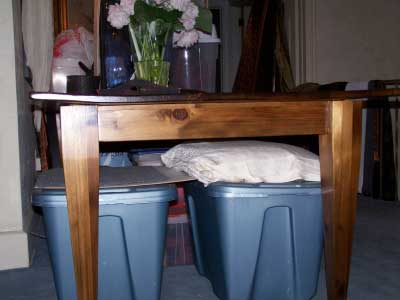Question
I build props for event decorating/rental and a while back I built 4 cedar harvest tables, on the fly, measuring 43" x 104". The top construction is 9 board biscuit joinery (alternating grain) - 1" thickness. Because of the urgency I didn't attach my aprons to the table top until the day of the event and the next day they were disassembled, transported and stored - separate tops, legs and aprons. Within 2 weeks I caught sight of the tops belly dancing into s-curves and cupped edges (as in the image below) at the tables ends, while the long outside edges remained pretty much true.
I know that had I properly joined the top to the apron immediately, and maybe added breadboard ends, I might have avoided this result. Similarly, gluing, clamping and screwing doesn't feel like it's going to be enough persuasion at this time, especially on the tops with the cupping on the corner edges (like the image below).
I've experimented with cedar steam bending - it's nice and I like it, but I'm apprehensive to try to build something big enough to house one of these tops if my chances of success are limited. What do you steam savvy carpenters think? Or how best to approach repair without steam and without widdling my big tables into consoles?

Forum Responses
(Furniture Making Forum)
From contributor H:
Was the bottom side of this top finished equally to the top? To me it doesnt look like it because it absorbed more moisture than the top and expanded causing the curve upward. Screwing it down will only serve to make the top crack.
You need to:
1. Assure in the future that the wood is at equilibrium with its environment, as it takes a MC change for wood to warp. Then use a vapor resistant coating so that any RH changes will not rapidly affect the wood moisture content.
2. At this point, you need to restore the piece to flatness. Adding water slowly will not do a great job. Rather, add moisture quickly to the cupped face (the top). This will flatten the table. Then slowly re-dry it to the correct MC, holding it flat. It will likely not be perfectly flat, so you may need a large drum sander.
3. Alternate plan. Rip it into several pieces, joint the new edges that are perpendicular to the face and re-glue. Then sand it smooth.
Note: There is so much cup that even if you had secured the edges to the skirt, I doubt that you could have held it flat.